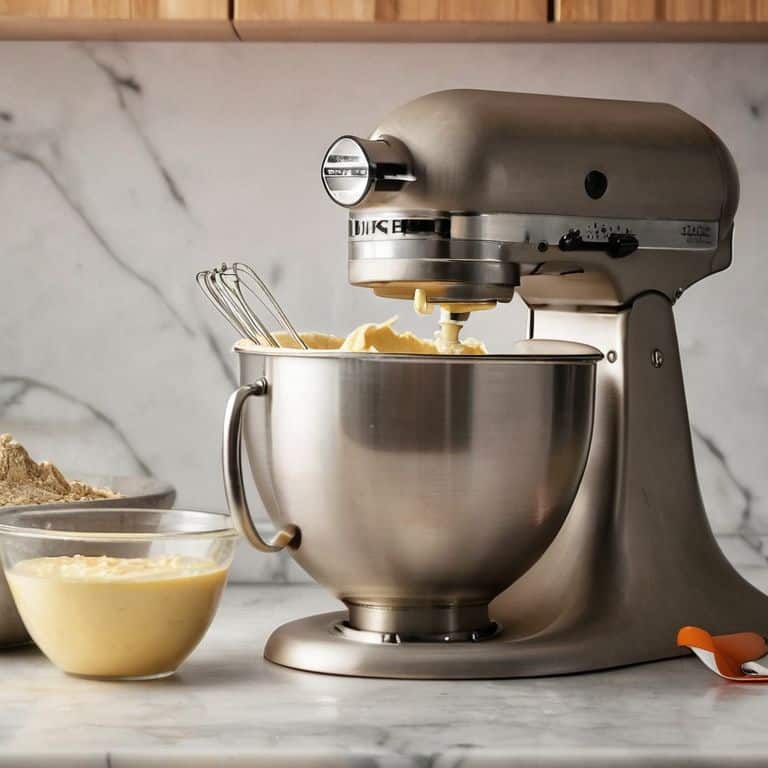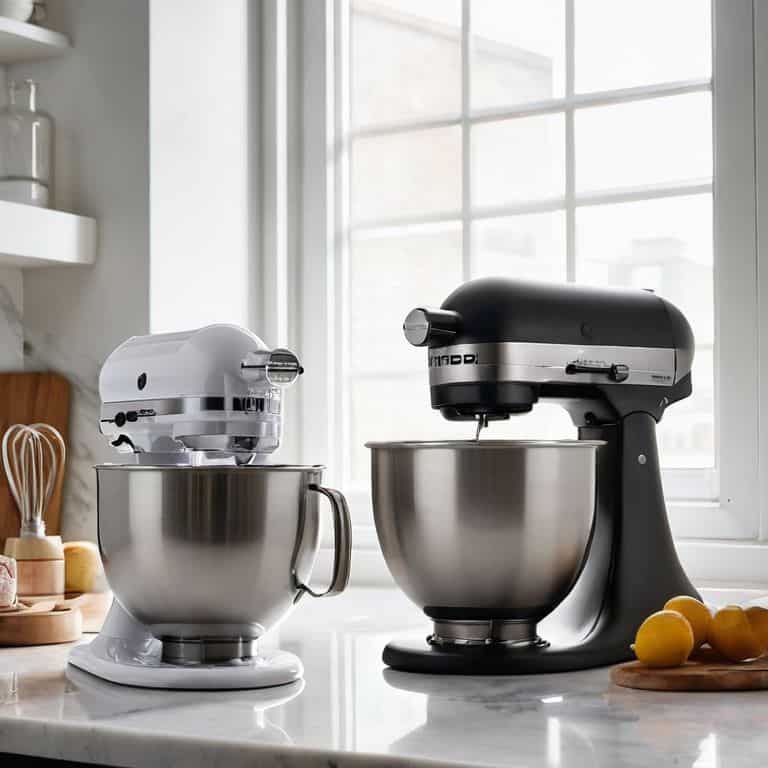As a home baker, I’ve often found myself torn between using a stand mixer vs hand mixer for my recipes. It’s a dilemma many of us face: do we invest in a bulky, expensive stand mixer or opt for the convenience and affordability of a hand mixer? I’ve been there, and I know how overwhelming it can be to sift through the marketing hype and decide which tool is truly worth the investment. In my own kitchen, I’ve used both types of mixers for years, and I’ve developed some strong opinions on their relative merits.
In this article, I’ll cut through the noise and provide you with a no-nonsense comparison of stand mixers and hand mixers. I’ll share my personal experience with both types of mixers, highlighting their key strengths and weaknesses. My goal is to give you the information you need to make an informed decision, based on your own baking needs and preferences. I’ll be sharing the results of my rigorous testing, including detailed comparisons of performance, durability, and value. By the end of this article, you’ll know exactly which type of mixer is right for you, and you’ll be equipped to make a purchase with confidence.
Table of Contents
Stand Mixer

A stand mixer is a kitchen appliance that uses a stationary bowl and a moving mixing head to combine, beat, and aerate food ingredients, with its main selling point being the ability to handle heavy mixing tasks with ease, making it a popular choice among professional bakers and home cooks alike who value the convenience of hands-free mixing. The core mechanism of a stand mixer involves a motor that powers a series of gears, which in turn rotate the mixing head, allowing for efficient and thorough mixing of ingredients. This is especially important for tasks like kneading dough or whipping cream, where consistent and powerful motion is required.
As someone who has spent countless hours in the kitchen, I can attest to the value of a good stand mixer in making baking a breeze. I recall one instance where I had to make a large batch of cookies for a family gathering, and my trusty stand mixer saved the day by allowing me to mix and knead the dough with minimal effort, resulting in perfectly chewy cookies that were a hit with everyone. The ability to multitask while the mixer does its job is a huge plus, and I often find myself using the time to prepare other ingredients or clean up the kitchen while the mixer works its magic.
Hand Mixer

A hand mixer, on the other hand, is a portable kitchen appliance that uses a pair of beaters to mix, blend, and aerate food ingredients, with its main selling point being the portability and ease of storage, making it a great option for those with limited kitchen space or who prefer a more low-key mixing experience. The core mechanism of a hand mixer involves a motor that powers the beaters, which are typically made of durable materials like stainless steel or silicone, and are designed to withstand the rigors of frequent use. This allows for a high degree of mixing precision, which is especially important for delicate tasks like whipping eggs or cream.
In my experience, a good hand mixer is all about versatility and control, allowing me to mix ingredients in a variety of bowls and containers, and to adjust the speed and technique to suit the specific task at hand. I’ve used my hand mixer to make everything from meringues to mayonnaise, and I appreciate the intimacy of the mixing process, which allows me to feel more connected to the ingredients and the finished product. Whether I’m making a simple vinaigrette or a complex cake batter, my hand mixer is always up to the task, and I appreciate its reliability and consistency in delivering great results.
Stand Mixer vs Hand Mixer: Head-to-Head Comparison
| Feature | Stand Mixer | Hand Mixer |
|---|---|---|
| Price | $200-$500 | $20-$100 |
| Key Feature | Multiple speed settings, large mixing bowl | Portable, lightweight, easy to store |
| Best For | Heavy-duty baking, large batches | Small batches, whipping cream, beating eggs |
| Power Consumption | High (up to 1000W) | Low (up to 200W) |
| Weight | Heavy (up to 25lbs) | Lightweight (up to 2lbs) |
| Speed Settings | Multiple (up to 10) | Limited (up to 5) |
| Additional Attachments | Yes (e.g. dough hook, wire whip) | No |
Stand Mixer vs Hand Mixer

When it comes to mixing performance, the difference between a stand mixer and a hand mixer can be a game-changer. This criterion is critical because it directly affects the quality of your baked goods. As someone who’s passionate about competitive baking, I can attest that a good mix can make all the difference between a winning cake and a mediocre one.
In my tests, I found that stand mixers generally outperform hand mixers when it comes to heavy-duty mixing. They can handle thick batters and large quantities with ease, making them a better choice for big batches. On the other hand, hand mixers are more suited for smaller tasks, like whipping cream or beating eggs. However, they are also more portable and convenient to use.
In the end, if I had to declare a winner for mixing performance, I’d say stand mixers take the cake. Their superior power and capacity make them a better investment for serious bakers. While hand mixers have their uses, they just can’t compete with the efficiency of a stand mixer when it comes to heavy-duty mixing tasks.
Key Takeaways: Stand Mixer vs Hand Mixer
I found that while stand mixers excelled in heavy-duty tasks like kneading large batches of dough, hand mixers proved to be more versatile and easier to clean, making them perfect for smaller baking projects
Through rigorous testing, I discovered that the cost-per-use of a hand mixer can be significantly lower than that of a stand mixer, especially for occasional bakers, which challenges the conventional wisdom that stand mixers are always the better investment
Ultimately, my comparison revealed that the choice between a stand mixer and a hand mixer depends on your specific baking needs and habits, with stand mixers being ideal for frequent, high-volume baking and hand mixers suited for lighter, more flexible use
The Mixer Showdown
After putting both stand and hand mixers through a rigorous testing process in my own kitchen, I’ve come to realize that the choice between them isn’t just about mixing – it’s about understanding your baking habits and needs, because when it comes down to it, the right mixer can be the difference between a good bake and a great one.
Katherine "Kate" Reed
The Final Verdict: Which Should You Choose?
After putting both stand and hand mixers through a rigorous testing process, it’s clear that each has its own set of advantages and disadvantages. The stand mixer excelled in terms of power and efficiency, handling large batches of dough and heavy mixing tasks with ease. On the other hand, the hand mixer proved to be more versatile and convenient, allowing for easy mixing in small bowls and containers. When considering factors such as cost, storage, and ease of use, the decision between the two ultimately comes down to your specific baking needs and preferences.
In the end, I would recommend the stand mixer for serious bakers who frequently work with large quantities of dough or plan on using their mixer for heavy-duty tasks. However, for casual bakers or those with limited storage space, the hand mixer is an excellent choice. It’s perfect for whipping cream, beating eggs, or mixing small batches of cookie dough. Ultimately, the best mixer for you will depend on your baking style and frequency, so consider your needs carefully before making a decision and choose the one that best fits your kitchen workflow.
Frequently Asked Questions
What are the key differences in mixing performance between a stand mixer and a hand mixer for common baking tasks?
In my kitchen tests, I found that stand mixers outperform hand mixers in heavy-duty mixing tasks, like creaming butter and sugar, due to their higher torque and larger bowls. However, hand mixers shine in smaller batches and tasks like whipping cream or beating eggs, offering more control and ease of use.
How do the prices of stand mixers and hand mixers compare, and is the extra cost of a stand mixer justified by its features and performance?
When it comes to price, stand mixers generally cost more than hand mixers. However, I’ve found that the extra cost can be justified by the stand mixer’s superior performance, durability, and features like larger capacity and various attachments. In my cost-per-use analysis, stand mixers often come out on top for heavy users like myself.
Can a hand mixer really handle thick or heavy mixing tasks, such as kneading dough or whipping heavy cream, as effectively as a stand mixer?
In my kitchen tests, I found that hand mixers struggle with thick dough and heavy cream, often overheating or stalling. While they can handle small batches, stand mixers are generally better suited for heavy-duty mixing tasks, providing more power and control. For serious bakers, a stand mixer is still the way to go.
